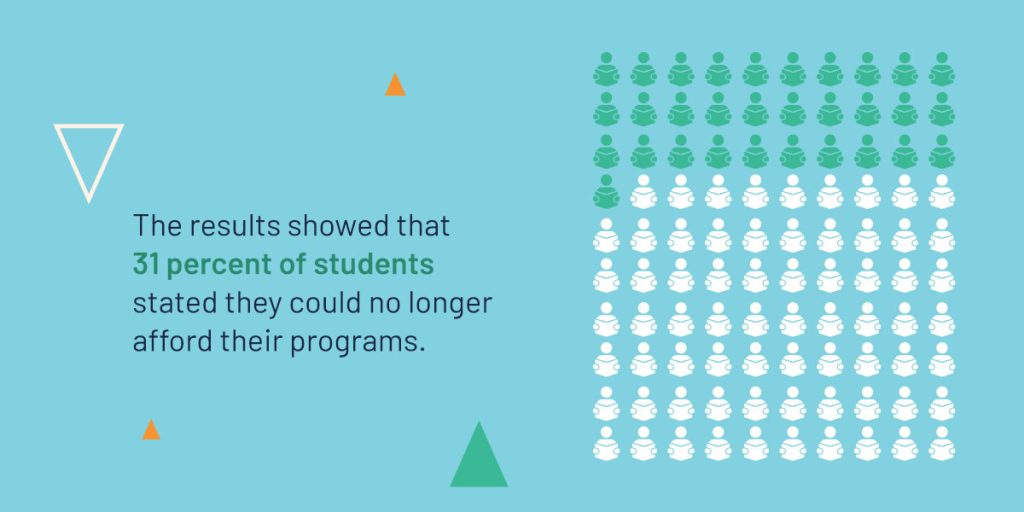
Stopout students are those who put their education on pause to return at a later date. Several factors influence this decision, from financial issues to a lack of academic support. When students temporarily leave, it negatively impacts the higher education institution’s retention and graduation rates. It could also affect the institution’s rankings and eligibility for certain grants and funding.
For this reason, it is crucial to provide easily accessible career and financial aid support to students of all backgrounds to retain stopout students. Read this guide to understand the most common reasons students stop out and learn the top six intervention strategies to support at-risk students, from diversifying revenue to providing career services.
Reasons students become stopout students
To implement effective retention strategies, you must understand why the students at your institution are stopping out. You can then create intervention programs that counter those issues. Consider these common reasons students stop out of higher education institutions:
Financial issues
Finances are among the top reasons students become at risk of stopping out of college. Certain costs may be overwhelming, especially for students from low-income backgrounds, including tuition, living expenses, fees, and books. These financial needs can cause students to work long hours and have less time to focus on their studies.
Recently, New America conducted a survey to uncover the most common reasons students stop out. The results showed that 31 percent of students stated they could no longer afford their programs.

Academic challenges
When students find it challenging to keep up with coursework, meet academic expectations, or maintain good grades, they may feel overwhelmed and leave temporarily. This issue can be especially prominent in institutions with fewer resources or academic support programs.
Mental health issues
Stress and mental health can also influence stop-out rates. These issues stem from personal issues, academic pressures, social challenges, and financial issues. When students become too stressed, it limits their ability to succeed and can lead them to temporarily leave the institution.
Personal circumstances
Students may feel overwhelmed when they have numerous responsibilities. Some potential responsibilities might include caring for a family, working, or navigating professional relationships. In the recent New America survey, nearly half of the participating students who left community college stated that work was a major reason why they were no longer enrolled.
6 strategies to retain stopout students in higher education
The best way to assist potential stopout students is by reducing their personal and academic challenges. Explore these effective retention strategies to support at-risk students during the summer transition.
1. Implement early warning systems and intervention programs
To help at-risk students in a timely manner, you need a predictive analytics system for identifying them within your institution. An early warning system may identify these students and send an alert to the institution that they are at risk of dropping out or stopping out. This system identifies these students by keeping track of academic performance, engagement, and attendance.
These alerts give faculty members and institutional leaders the time they need to speak with the student about relevant support programs. It also helps you understand the type of interventions and programs the institution should implement. One intervention program strategy could include employing retention specialists who can speak with at-risk students and develop personalized plans to address their unique challenges.
Using data and analytics offers an effective way to improve institutional success. For example, Western Kentucky University (WKU) used data and analytics to identify early student success risk factors, balance record-high retention rates, optimize financial aid awarding, and increase student enrollment.
2. Offer financial support and counseling
If the students at your institution are having financial issues, consider offering financial support and counseling. Increase the availability of scholarships and grants for students from low-income communities. You want to ensure that financial support is accessible to all students.
The University of Central Oklahoma has especially succeeded in financial assistance with its support and IT services. The institution increased student satisfaction and retention by providing 24/7 access to support services online. If you already provide these resources, consider alternative revenue generation options for colleges. Create fundraising opportunities as a source of higher education revenue generation to sponsor grants.
The institution could also create financial literacy programs. These include offering workshops on financial planning, budgeting, and managing student loans for more informed financial decision-making. Make sure that your students are aware of the support programs the institution offers. Market these programs during recruitment, enrollment, and quarterly workshops to remind students of their options.
3. Create academic support services
Consider using some institutional revenue streams to expand your academic support services by offering more accessible advisors. If students have less flexible schedules, offer online advisor support that allows students to schedule appointments at more convenient times. Provide tutoring services and proactive academic advising that help student stay on track with their studies. These advisors assist with academic planning, course selection, and identifying at-risk students early.
Many institutions are taking a data-informed approach to program offerings. For instance, the University of Wisconsin Board of Regents reviewed academic programs across the state to understand how they can improve their underenrolled programs to meet student needs and state requirements.
4. Enhance campus engagement
Decrease social and academic challenges by fostering a strong support system with peers experiencing similar challenges. On-campus clubs, extracurricular activities, and organizations help students build better connections with others outside of class. You can also establish mentorship programs that pair students with faculty or peer mentors for extra support and guidance.
5. Provide career services and internships
Career services, such as interview preparation, resume building, and job search assistance, help students see the long-term impact of completing their degree. Internship opportunities also give students the connections they need to attain practical experience and improve job prospects. These opportunities allow students to feel like the investment in education is worth it.
6. Develop mental health and wellness programs
Establish peer support groups and regular wellness checks to combat mental health issues. Mental health counseling services support stressed and overwhelmed students. Another strategy includes offering stress management workshops to address coping strategies, stress management, and mindfulness. These topics equip students with the tools and knowledge needed to handle personal and academic pressures.
Track student retention with Watermark Student Success & Engagement
While there are various effective strategies, the key to boosting reenrollment and retention rates is timely intervention. A valuable resource for identifying these students is a student success and retention software solution.
Watermark Student Success & Engagement is a solution that tracks student success and retention. It monitors core metrics, provides early alerts for at-risk students, helps you collaborate with students to create success plans, and offers online student support. To improve your support system, learn more about our solution and request a demo with Watermark today.
















































































































































































































































































































































































































